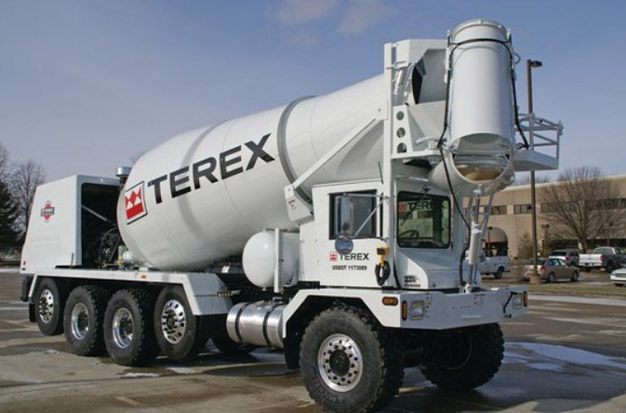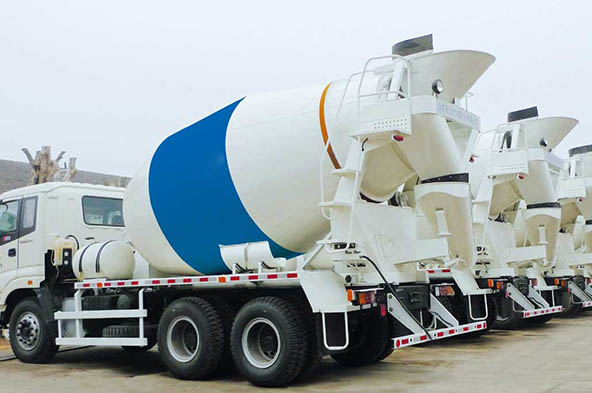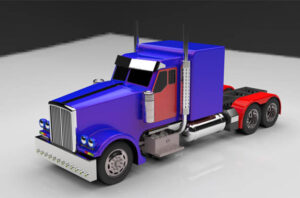
How Many Yards of Concrete in a Truck?
Due to the weight limitation of road supervision, the truck can usually carry a light load of 8 to 11 cubic yards, and the drum rotates slowly during transportation, so the concrete will not start to set when it is transported to the construction site. The truck weighs about 20000 to 30000 pounds (9070 to 13600kg) and can transport about 40000 pounds (18100kg) of concrete, so the most common truck can transport 8 to 11 cubic yards of concrete.
How Many Yards Can a Concrete Truck Load?
Most concrete trucks will carry 8 yards of concrete, but if it is a fully loaded truck, it can carry 10 cubic yards of concrete. There are larger and smaller trucks than this, but this is the average size. This is a perfect size for general residential work, such as patios, steps, and smaller driveways. The average weight of these trucks is about 20000 to 30000 pounds, and they can transport more than 40000 pounds of concrete.
Some concrete trucks can carry more goods, but these trucks are usually found on large commercial sites. These can accommodate 14 yards or more of concrete. In large commercial or industrial projects, concrete needs to be poured quickly, and these trucks work better. A single footing of a large project (such as bridge footing) may require 100 yards or more to be poured at a time, as well as the use of the entire concrete professional team.
There are also small ready mixed concrete trucks, which can load about 4 yards of concrete. These tools are very suitable for small operations that do not require a full load of concrete trucks to be transported to the site. If concrete is needed in narrow spaces (such as narrow urban streets or small backyards), they are ideal cement trucks. Its smaller size makes it more operable in such cases. If the ready mixed concrete truck with large weight restrictions can drive, its size is also beneficial.
How Much is a Cubic Yard of Concrete?
If you want to compare it with bagged concrete that you can buy in the store, 90 bags of 45 pounds, 60 bags of 60 pounds or 45 bags of 80 pounds of concrete mixture are required for each cubic yard of ready mixed concrete. If you want to compare it with square feet, a cubic yard of concrete will cover 54 to 81 square feet, depending on the thickness you pour.
Although we measure buildings in feet and inches or even one square foot or square inch, concrete is measured in cubic yards. To convert feet to square yards, you need to do simple mathematical calculations. To determine cubic feet, take the square feet of the item (length x width), multiply it by the required depth of the item converted to feet (this will give cubic feet), and finally divide this number by 27 (cubic feet in cubic yards).
For example, if we want to pour a 10 x 10 patio, we will take 10 x 10 and give us 100 square feet. Let’s assume 100 and multiply by. For the 4-inch expected thickness of our finished mat, this will give us 33 cubic feet. Finally, divide by 27 to get 1.22 yards of concrete. You also need to add about 10% to the final total to explain any spillovers, losses, or calculation errors.
Concrete Trucks Come in Different Sizes
The average size concrete truck can load 8-10 cubic yards of concrete. However, there are also larger and smaller concrete trucks. The size of an 8-10 cubic yard truck is suitable for residential projects such as courtyards, foundations, driveways or steps.
Larger concrete trucks can transport more than 14 yards of concrete. These trucks are usually used for large commercial or industrial projects that require rapid pouring of large quantities of concrete.
In many cases, such as bridges, dams and large foundations, concrete pouring needs to be completed at one time before the concrete solidifies. A footing can easily accommodate more than 100 yards of concrete. I have done business work and poured more than 100000 yards of concrete. Larger trucks are more suitable for this scale of work, because you don’t need so much. The fewer trucks you bring, the less likely errors or mechanical problems will occur. An important part of the work is to manage the delivery and placement of concrete. All large construction projects require a lot of concrete, so builders prefer large trucks.
The small concrete truck can load about 4 yards of concrete. This is very good for cities with tight streets and real estate. Larger concrete trucks are really heavy and consume a lot of fuel, so you can use a small truck to deliver goods in small quantities and save money. If you are pouring a set of concrete steps or setting up fences, these trucks are great. Trucks are easier to operate and drive.

How Much is the Charge for Concrete?
Usually, the concrete company will charge you a certain fee per cubic yard. This number may vary depending on your needs and your location. The cost of concrete may range from $100 to $150 per yard.
Specific freight will also be charged. This is usually a fixed rate charge to cover the high fuel costs and the time spent loading concrete trucks, delivering concrete, and unloading concrete after it arrives at the construction site. If it takes too long, most companies will charge a fee, which will increase the total cost. Usually, the company begins to charge hourly fees for each hour spent on the job site after the first hour.
There is also the so-called short load. Short load refers to the small load of concrete. Usually 1 to 9 cubic yards of concrete, sometimes mixed on site. It is also common for concrete companies to charge extra for delivering such small goods. When pouring concrete slabs or large projects, if a larger quantity is required, such as 13 or 14 yards of ready mixed concrete, it is best to order loads of the same size. This will save you time overruns and short-term loading fees, giving you more time to deal with each pour instead of having an overly large pour first.
What do I need to do when the truck carrying concrete arrives?
When you deliver the concrete, you should be ready for the concrete to arrive or be very close. A full load of cement trucks will not wait for you. You will start charging by the hour, increasing your final cost. You need to lay the gravel and compact it. You need to make the formwork, the reinforcement is in place, and all the equipment is ready to complete the concrete.
When you call your trusted concrete supplier, they should be willing to send a representative to your house to discuss what kind of concrete you need and how many cubic yards you may need.
What Does the Concrete Company Need to Know?
When you call the concrete company, they are likely to ask you some questions. However, in order to help the process go smoothly, please make sure you know how many cubic yards of concrete you need, let them know whether your intended purpose is to seal or keep it smooth, and how long you plan to use the product. The company needs to know how many cubic yards of concrete you need to ensure that they bring the right amount, no waste, and no shortage of you. When you tell the company how much you need, you have added an extra 10% of waste and measurement errors. You will want to have a little residual concrete as much as possible. They need to know what concrete is for. For example, lanes require a different mixture from the foundation wall. The mixed concrete is not exactly the same and will be mixed according to your specific purpose, which means they need to know what you want it to do. Will it be a smooth workshop, a driveway left outside, or a step leading to your home? All these can be attributed to different aspects of concrete. If you intend to stamp on the concrete, you must let the representative know. This means that they must ensure that the concrete dries slowly so that they have extra time to crush it before drying.
The time you want to use it will play a similar role. If you pour only yourself or oneortwo people on a 10 yard long pouring car or a fully loaded cement truck, it will be difficult for you to finish it before it begins to dry. You should discuss this with your representatives and let them mix the slow drying concrete if necessary to help you have time to finish the concrete before it dries properly.
Do I Need Concrete Support?
It will depend on the type and thickness of the concrete project you are working on. If you are pouring a concrete slab, which is one of the most common support positions, it will fall to the thickness of the concrete slab. If you are pouring a 4 inch thick concrete slab, you may not need to add reinforcement or mesh. If you are pouring a 5 or 6-inch concrete slab, you may need to add metal supports. It can be steel mesh or barbed wire. You can pour concrete on it. There are many other structural types that also require metal support. If you are not sure whether you need metal supports, you should discuss with the concrete contractor to ensure that your project is completed correctly.
How to Choose Which Concrete Company to Use?
The problem with ordering concrete is the time limit or rotation limit of the concrete in the truck. The concrete truck is similar to the cement mixer. Once the concrete is mixed, the company will need to pour it from the truck within a specific time, otherwise it will no longer be good. If they have to add more water to the mixture, it may cause the concrete to weaken.
If you choose a specific company that is too far away, it may lead to additional costs. They may charge you more for delivery, because it will waste time and product opportunities. According to the American Concrete Association, the concrete must be unloaded from the truck within one and a half hours, or 300 revolutions, whichever comes first.
It will help if you are looking for a specific company that has a close relationship with you to ensure that you do not waste products or charge unnecessary fees. However, choosing a specific company is not just a matter of location.
Location: due to time constraints, location will be an important factor in selecting a specific company.
Recommendation: talk to people in the local hardware store, or if you know any contractors who usually use concrete contractors, you can ask them to recommend them.
Other recommendations: if you don’t get any recommendations from the hardware store, or don’t know any specific contractors, you can get some specific company phone numbers from the phone book. Make sure they are close to your project location, and then call them. Ask them if they can recommend their customers for you, so that you can ensure that they are very suitable for your project.
Conclusion
RMC trucks contain 11 to 15 cubic yards or 8m3 to 11m3 of concrete. However, due to the weight limitations on the road, they can transport 8 to 11 cubic yards or 6m3 to 8m3 of concrete. The most common is 8-10 cubic yards. For road projects, a small amount of concrete needs to be transferred to different locations, so small trucks can accommodate 5 cubic yards.
Learn more about how to transport the following items together!
- How to Ship & Transport Frozen Breast Milk
- How to Transport a Mini Fridge In Simple Ways?
- How To Transport A Charcuterie Board – Pack & Transport
- How to Transport a Bike Without a Rack – 3 Common & Useful Ways
- How to Transport Cupcakes In the Most Simple & Economical Way
- How to Transport Drywall in Truck – Safe & Simple Ways
- How To Transport A Dirt Bike With Simple Ways?
- How to Load and Transport a Motorcycle into a Truck?
- How to Transport Chickens in a Truck – Tips and Tricks
- How Should Firearms Be Transported in a Truck?
- How to Transport a Kayak in a Truck?



Average Rating